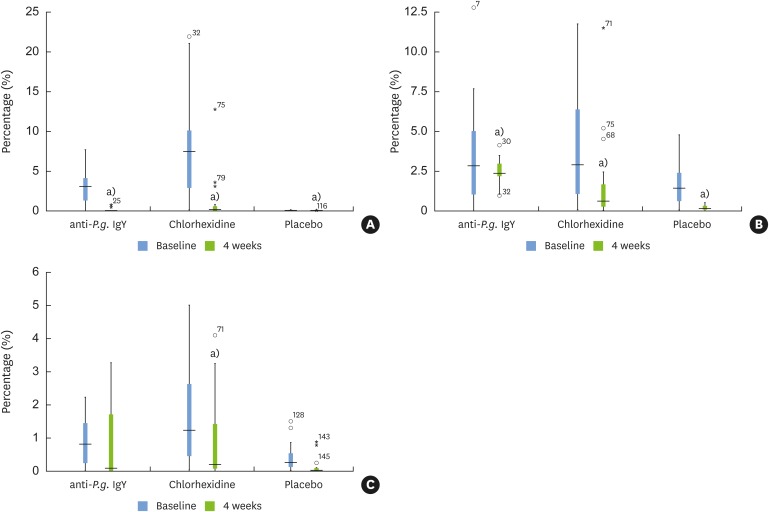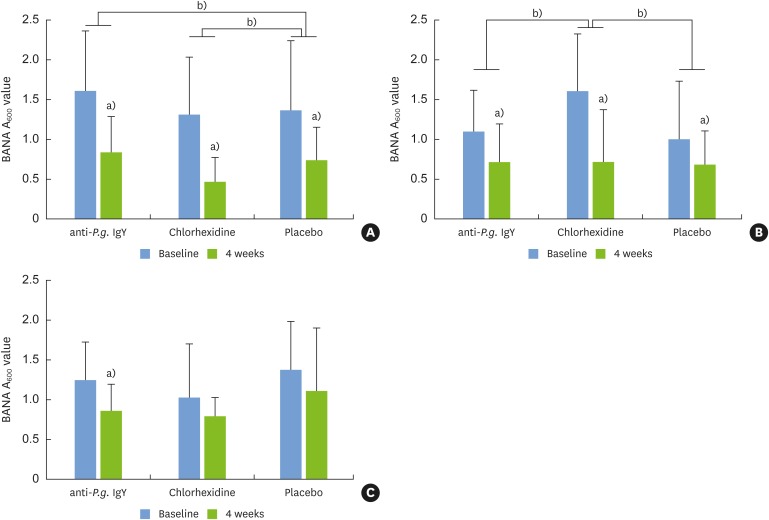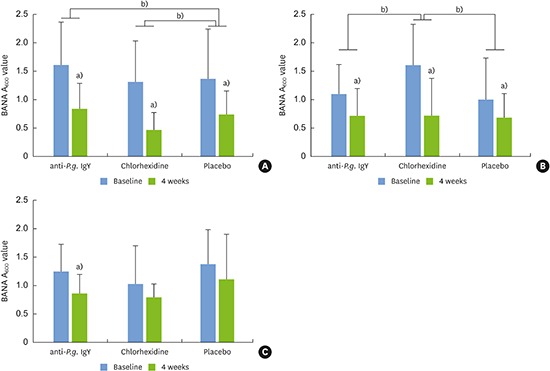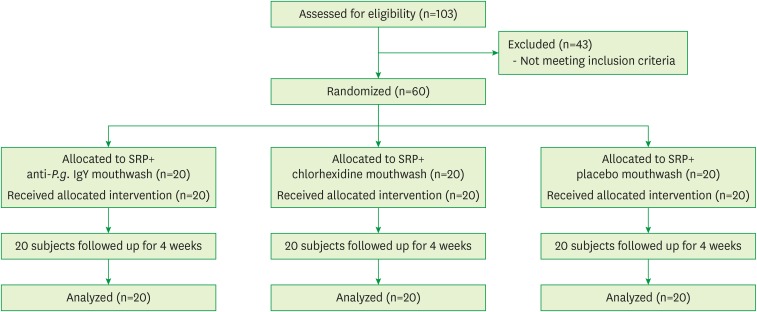1. Sanz M, van Winkelhoff AJ. Periodontal infections: understanding the complexity--consensus of the Seventh European Workshop on Periodontology. J Clin Periodontol. 2011; 38(Suppl 11):3–6. PMID:
21323698.
2. Corbet EF, Leung WK. Epidemiology of periodontitis in the Asia and Oceania regions. Periodontol 2000. 2011; 56:25–64. PMID:
21501236.

3. Dye BA. Global periodontal disease epidemiology. Periodontol 2000. 2012; 58:10–25. PMID:
22133364.

4. Grenier D, Mayrand D. Periodontitis as an ecological imbalance. In : Kuramitsu HK, Ellen RP, editors. Oral bacterial ecology: the molecular basis. Wymondham: Horizon Scientific;2000. p. 275–310.
5. Slots J, Ting M. Actinobacillus actinomycetemcomitans and
Porphyromonas gingivalis in human periodontal disease: occurrence and treatment. Periodontol 2000. 1999; 20:82–121. PMID:
10522224.
6. Holt SC, Kesavalu L, Walker S, Genco CA. Virulence factors of
Porphyromonas gingivalis. Periodontol 2000. 1999; 20:168–238. PMID:
10522227.
7. Bostanci N, Belibasakis GN.
Porphyromonas gingivalis: an invasive and evasive opportunistic oral pathogen. FEMS Microbiol Lett. 2012; 333:1–9. PMID:
22530835.
8. Slots J, Ting M. Systemic antibiotics in the treatment of periodontal disease. Periodontol 2000. 2002; 28:106–176. PMID:
12013339.

9. Handal T, Caugant DA, Olsen I. Antibiotic resistance in bacteria isolated from subgingival plaque in a Norwegian population with refractory marginal periodontitis. Antimicrob Agents Chemother. 2003; 47:1443–1446. PMID:
12654689.

10. James P, Worthington HV, Parnell C, Harding M, Lamont T, Cheung A, et al. Chlorhexidine mouthrinse as an adjunctive treatment for gingival health. Cochrane Database Syst Rev. 2017; 3:CD008676. PMID:
28362061.

11. Klemperer PF. Ueber natürliche immunität und ihre verwerthung für die immunisirungstherapie. Arch Exp Pathol Pharmakol. 1893; 31:356–382.

12. Schade R, Hlinak A. Egg yolk antibodies, state of the art and future prospects. ALTEX. 1996; 13:5–9. PMID:
11178463.
13. Xu FX, Xu YP, Jin LJ, Liu H, Wang LH, You JS, et al. Effectiveness of egg yolk immunoglobulin (IgY) against periodontal disease-causing
Fusobacterium nucleatum
. J Appl Microbiol. 2012; 113:983–991. PMID:
22789022.
14. Yokoyama K, Sugano N, Rahman AK, Oshikawa M, Ito K. Activity of anti-
Porphyromonas gingivalis egg yolk antibody against gingipains
in vitro. Oral Microbiol Immunol. 2007; 22:352–355. PMID:
17803634.
15. Nilsson E, Larsson A, Olesen HV, Wejåker PE, Kollberg H. Good effect of IgY against Pseudomonas aeruginosa infections in cystic fibrosis patients. Pediatr Pulmonol. 2008; 43:892–899. PMID:
18680179.
16. Suzuki H, Nomura S, Masaoka T, Goshima H, Kamata N, Kodama Y, et al. Effect of dietary anti
Helicobacter pylori-urease immunoglobulin Y on
Helicobacter pylori infection. Aliment Pharmacol Ther. 2004; 20(Suppl 1):185–192. PMID:
15298626.
17. Wilhelmson M, Carlander D, Kreuger A, Kollberg H, Larsson A. Oral treatment with yolk antibodies for the prevention of C. albicans infections in chemotherapy treated children. A feasibility study. Food Agric Immunol. 2005; 16:41–45.
18. Armitage GC. Development of a classification system for periodontal diseases and conditions. Ann Periodontol. 1999; 4:1–6. PMID:
10863370.

19. World Medical Association General Assembly. World Medical Association Declaration of Helsinki: ethical principles for medical research involving human subjects. J Int Bioethique. 2004; 15:124–129. PMID:
15835069.
20. Löe H. The gingival index, the plaque index and the retention index systems. J Periodontol. 1967; 38:610–616.

21. Schade R, Calzado EG, Sarmiento R, Chacana PA, Porankiewicz-Asplund J, Terzolo HR. Chicken egg yolk antibodies (IgY-technology): a review of progress in production and use in research and human and veterinary medicine. Altern Lab Anim. 2005; 33:129–154. PMID:
16180988.

22. Sugano N. Adjunctive effects of anti-porphyromonas gingivalis egg yolk antibody with scaling and root planing: a randomized, placebo-controlled clinical trial. J Periodontol. 2009; 80:1901–1903.
23. Yokoyama K, Sugano N, Shimada T, Shofiqur RA, Ibrahim ES, Isoda R, et al. Effects of egg yolk antibody against
Porphyromonas gingivalis gingipains in periodontitis patients. J Oral Sci. 2007; 49:201–206. PMID:
17928726.
24. Plessas A. Nonsurgical periodontal treatment: review of the evidence. Oral Health Dent Manag. 2014; 13:71–80. PMID:
24603920.
25. Müller HP, Hartmann J, Flores-de-Jacoby L. Clinical alterations in relation to the morphological composition of the subgingival microflora following scaling and root planing. J Clin Periodontol. 1986; 13:825–832. PMID:
3537017.

26. Xu Y, Li X, Jin L, Zhen Y, Lu Y, Li S, et al. Application of chicken egg yolk immunoglobulins in the control of terrestrial and aquatic animal diseases: a review. Biotechnol Adv. 2011; 29:860–868. PMID:
21787857.

27. Hanes PJ, Purvis JP. Local anti-infective therapy: pharmacological agents. A systematic review. Ann Periodontol. 2003; 8:79–98. PMID:
14971250.

28. Socransky SS, Haffajee AD, Teles R, Wennstrom JL, Lindhe J, Bogren A, et al. Effect of periodontal therapy on the subgingival microbiota over a 2-year monitoring period. I. Overall effect and kinetics of change. J Clin Periodontol. 2013; 40:771–780. PMID:
23710672.

29. Shiloah J, Patters MR. Repopulation of periodontal pockets by microbial pathogens in the absence of supportive therapy. J Periodontol. 1996; 67:130–139. PMID:
8667133.

30. Petersilka GJ, Ehmke B, Flemmig TF. Antimicrobial effects of mechanical debridement. Periodontol 2000. 2002; 28:56–71. PMID:
12013348.

31. Greenstein G. Periodontal response to mechanical non-surgical therapy: a review. J Periodontol. 1992; 63:118–130. PMID:
1552465.

32. Socransky SS, Haffajee AD, Cugini MA, Smith C, Kent RL Jr. Microbial complexes in subgingival plaque. J Clin Periodontol. 1998; 25:134–144. PMID:
9495612.

33. Hajishengallis G, Lamont RJ. Beyond the red complex and into more complexity: the polymicrobial synergy and dysbiosis (PSD) model of periodontal disease etiology. Mol Oral Microbiol. 2012; 27:409–419. PMID:
23134607.

34. Adair JG. The Hawthorne effect: a reconsideration of the methodological artifact. J Appl Psychol. 1984; 69:334–345.

35. MA Coleman. Ovimmune, Inc.Oral administration of chicken yolk immunoglobulins to lower somatic cell count in the milk of lactating ruminants. United States patent. US 5,585,098. 1996. 12. 17.









 PDF
PDF ePub
ePub Citation
Citation Print
Print





 XML Download
XML Download